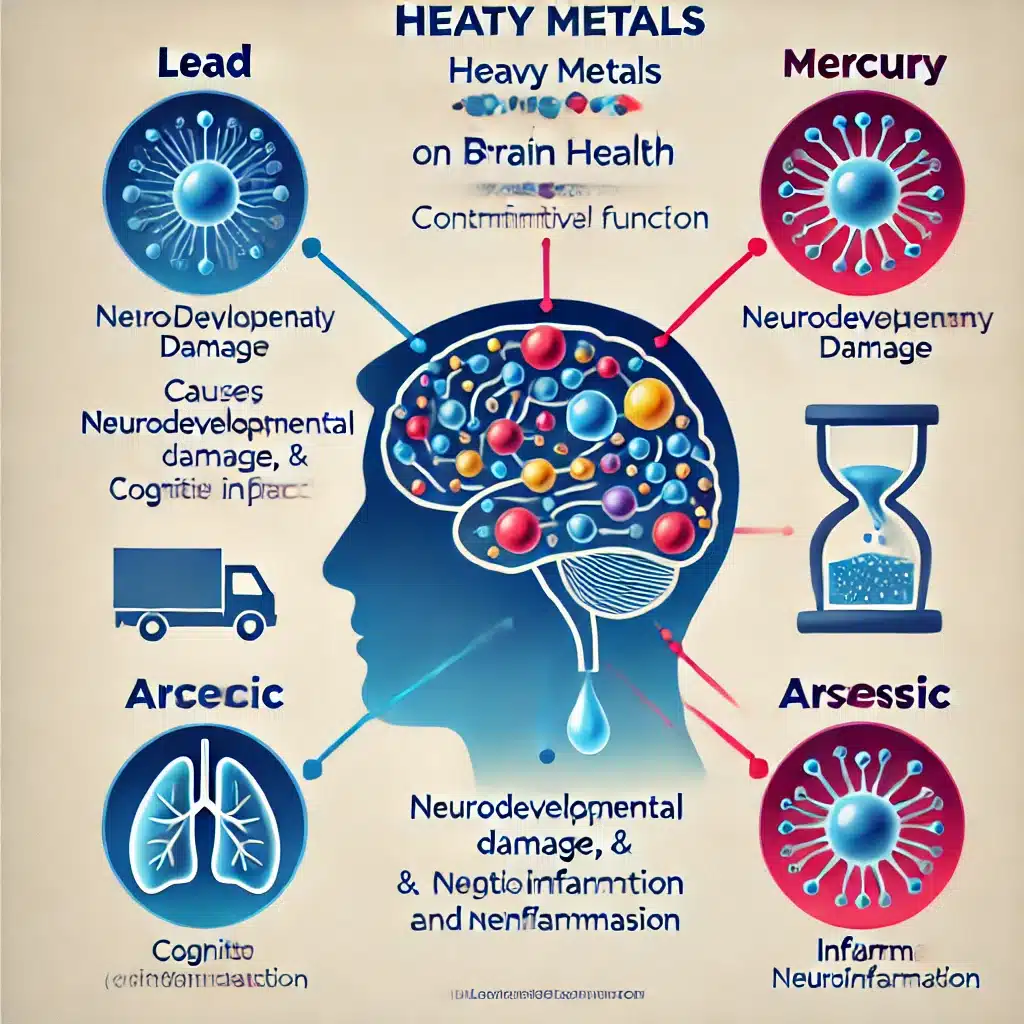Water pollution poses serious risks to human brain health, leading to neurological damage and increased risk of neuropsychiatric diseases.
Highlights:
- Sources of Pollution: Water sources are contaminated by industrial waste, agricultural runoff, and urban waste, introducing harmful chemicals like pesticides, inorganic salts, and organic compounds into drinking water.
- Neurological Impact: Chemicals such as acrylamide in water can cause neurotoxic effects like tremors and sensory ataxia, and have been linked to an increased incidence of brain tumors.
- Pesticides: Exposure to certain pesticides (e.g., carbamates, organochlorines, organophosphates) in water can lead to serious irreversible brain damage and increase the risk of neurodegenerative diseases.
- Toxic Metals: Chronic exposure to metals like aluminum, arsenic, lead, and cadmium in drinking water is associated with cognitive impairments and motor function deficits.
- Pharmaceutical Waste: Residual pharmaceuticals in water can negatively impact brain development and pose long-term health risks to current and future generations.
Source: Clinics (2024)
Common Sources of Water Pollution
Water pollution is a significant global issue, with various sources contributing to the contamination of water bodies.
1. Industrial Waste
Manufacturing Plants
- Chemicals: Factories discharge chemicals like heavy metals (lead, mercury), solvents, and hazardous waste into nearby water bodies.
- Byproducts: Industrial processes generate byproducts that contaminate water with pollutants such as PCBs (polychlorinated biphenyls) and dioxins.
Mining Operations
- Acid Mine Drainage: Mining activities expose sulfide minerals, which react with water and air to produce sulfuric acid, contaminating nearby streams and rivers.
- Heavy Metals: Mining releases heavy metals like arsenic, cadmium, and lead into water sources.
Oil Refineries
- Hydrocarbons: Refineries discharge hydrocarbons and petroleum products, leading to oil spills and contamination of aquatic ecosystems.
- Chemical Waste: Refineries also release chemicals like benzene, toluene, and xylene, which are harmful to human health and the environment.
Industrial Zones
- Areas with high concentrations of manufacturing plants and refineries, such as the Rust Belt in the United States and industrial regions in China and India.
Mining Regions
- Regions with extensive mining activities, including parts of South America (Peru, Brazil), Africa (South Africa, Ghana), and Southeast Asia (Indonesia, Philippines).
2. Agricultural Runoff
Pesticides and Herbicides
- Chemical Use: The extensive use of pesticides (e.g., organophosphates, carbamates) and herbicides (e.g., glyphosate) in agriculture leads to runoff into nearby water bodies.
- Impact: These chemicals disrupt aquatic ecosystems and pose health risks to humans, including neurological damage and increased cancer risk.
Fertilizers
- Nutrient Pollution: Excessive use of nitrogen and phosphorus fertilizers leads to nutrient runoff, causing eutrophication in water bodies.
- Algal Blooms: Nutrient pollution promotes harmful algal blooms, which produce toxins and deplete oxygen in water, affecting aquatic life.
Animal Waste
- Livestock Operations: Large-scale livestock farming produces significant amounts of animal waste, which can contaminate water with pathogens, nitrates, and ammonia.
- Pathogens: Runoff from animal waste introduces bacteria (e.g., E. coli, Salmonella) and viruses into water sources, posing health risks.
Agricultural Regions
- Intensive farming areas such as the Midwest in the United States, the Pampas in Argentina, and the Punjab region in India and Pakistan.
- Regions with concentrated animal feeding operations (CAFOs), including parts of the United States (Iowa, North Carolina), Europe (Netherlands, Germany), and China.
3. Urban Runoff
Stormwater Runoff
- Impervious Surfaces: Urban areas with extensive impervious surfaces (roads, sidewalks, parking lots) increase stormwater runoff, carrying pollutants into water bodies.
- Pollutants: Stormwater runoff contains oil, grease, heavy metals, and other pollutants from urban environments.
Sewage and Wastewater
- Combined Sewer Overflows (CSOs): In many cities, combined sewer systems overflow during heavy rainfall, discharging untreated sewage into rivers and streams.
- Pathogens and Nutrients: Untreated sewage introduces pathogens, nutrients, and chemicals into water sources, impacting human health and the environment.
Construction Activities
- Sediment Pollution: Construction sites contribute to sediment runoff, increasing turbidity and carrying pollutants like heavy metals and chemicals into water bodies.
- Chemical Spills: Accidental spills of construction materials and chemicals can contaminate nearby water sources.
Urban Areas
- Large cities with aging infrastructure and combined sewer systems, such as New York City, London, and Mumbai.
- Cities experiencing rapid urbanization and construction, including many in Southeast Asia (Bangkok, Manila) and Sub-Saharan Africa (Lagos, Nairobi).
4. Household Waste
Pharmaceuticals and Personal Care Products (PPCPs)
- Improper Disposal: Improper disposal of medications and personal care products leads to contamination of water sources.
- Impact: PPCPs contain active chemical ingredients that can disrupt aquatic ecosystems and pose risks to human health.
Cleaning Agents and Detergents
- Chemical Contaminants: Household cleaning agents and detergents introduce phosphates, surfactants, and other chemicals into water sources.
- Environmental Impact: These chemicals contribute to nutrient pollution and toxicity in aquatic environments.
Microplastics
- Sources: Microplastics originate from household products like cosmetics, clothing fibers, and plastic waste.
- Impact: Microplastics contaminate water sources, affecting aquatic life and potentially entering the human food chain.
Residential Areas
- Urban and suburban areas with high population densities and significant household waste generation. Coastal Regions
- Coastal areas where household waste and microplastics can easily enter marine environments, such as the Mediterranean coast and Southeast Asian coastlines.
5. Natural Disasters
Flooding
- Contaminant Spread: Flooding spreads contaminants from industrial sites, agricultural fields, and urban areas into water bodies.
- Pathogens: Floodwaters can introduce pathogens from sewage overflows and animal waste.
Hurricanes and Storm Surges
- Chemical Spills: Hurricanes and storm surges can cause spills of hazardous chemicals from industrial facilities and storage tanks.
- Salinity Changes: Storm surges can alter the salinity of freshwater systems, impacting water quality and aquatic life.
Flood-Prone Areas
- Regions prone to flooding, including river deltas (e.g., the Mississippi Delta) and monsoon-affected areas in South Asia.
- Coastal areas vulnerable to hurricanes, such as the Gulf Coast of the United States, the Caribbean, and the Philippines.
Mechanisms of Brain Damage Caused by Water Pollution

The mechanisms through which these pollutants affect the brain are complex and multifaceted, involving both direct and indirect pathways. Below is a detailed examination of these mechanisms.
1. Neurotoxic Chemicals
Acrylamide
Pathway: Acrylamide enters the body through contaminated drinking water and is absorbed in the gastrointestinal tract.
- Neurotoxicity: Acrylamide disrupts neurotransmission by altering synaptic functions and damaging neuronal cells.
- Oxidative Stress: It increases the production of reactive oxygen species (ROS), leading to oxidative stress and neuronal damage.
- Protein Adduct Formation: Acrylamide forms adducts with proteins, impairing their normal function and leading to cell death. Effects:
- Neurological Symptoms: Tremors, peripheral neuropathy, and sensory ataxia.
- Long-term Risks: Increased incidence of brain tumors and neurodegenerative diseases.
Pesticides
Pathway: Pesticides enter water supplies through agricultural runoff and are ingested through drinking water.
- Cholinesterase Inhibition: Organophosphates and carbamates inhibit acetylcholinesterase, leading to the accumulation of acetylcholine and disrupted neurotransmission.
- Mitochondrial Dysfunction: Pesticides induce mitochondrial dysfunction, resulting in energy deficits in neuronal cells.
- Oxidative Stress and Inflammation: Pesticides trigger oxidative stress and inflammatory responses in the brain, causing cellular damage. Effects:
- Neurodegenerative Diseases: Increased risk of diseases like Parkinson’s and Alzheimer’s.
- Mental Health Issues: Higher incidence of anxiety, depression, and cognitive impairments.
2. Toxic Metals
Aluminum
Pathway: Aluminum contamination occurs through industrial discharge and water treatment processes using alumina.
- Beta-Amyloid Aggregation: Aluminum promotes the aggregation of beta-amyloid proteins, a hallmark of Alzheimer’s disease.
- Neurofibrillary Tangles: It contributes to the formation of neurofibrillary tangles by affecting tau proteins.
- Oxidative Stress: Aluminum induces oxidative stress, leading to neuronal damage and cognitive decline. Effects:
- Cognitive Impairment: Linked to memory loss and reduced cognitive function.
- Neurodegenerative Diseases: Higher prevalence of Alzheimer’s disease in populations with high aluminum exposure.
Arsenic, Lead, Cadmium
Pathway: These metals contaminate water through industrial processes, mining activities, and improper waste disposal.
- DNA Damage: These metals cause direct DNA damage, leading to mutations and cell death.
- Disruption of Calcium Homeostasis: They interfere with calcium signaling, crucial for neuronal communication and plasticity.
- Oxidative Stress and Inflammation: Similar to other pollutants, these metals induce oxidative stress and inflammatory responses, damaging neuronal cells. Effects:
- Cognitive Dysfunction: Impaired learning, memory, and motor functions.
- Neurodevelopmental Disorders: Increased risk of developmental issues in children exposed to these metals.
3. Pharmaceutical Waste
Drug Residues
Pathway: Pharmaceuticals enter water sources through improper disposal and human excretion.
- Endocrine Disruption: Certain pharmaceuticals act as endocrine disruptors, altering hormone levels and affecting brain development and function.
- Neurotransmitter Imbalance: Drugs such as antidepressants and antipsychotics in water can disrupt normal neurotransmitter levels, affecting mood and cognition.
- Developmental Neurotoxicity: Exposure during critical periods of brain development can lead to long-term neurodevelopmental issues. Effects:
- Behavioral Changes: Altered behavior and mood disorders.
- Cognitive Impairment: Negative impact on memory, learning, and overall cognitive function.
4. General Mechanisms
Oxidative Stress
Pathway: Many pollutants increase the production of reactive oxygen species (ROS).
- Cellular Damage: ROS cause lipid peroxidation, protein oxidation, and DNA damage.
- Mitochondrial Dysfunction: Excessive ROS impair mitochondrial function, leading to energy deficits in neurons. Effects:
- Neurodegeneration: Progressive neuronal loss and dysfunction.
- Inflammation: Chronic oxidative stress leads to sustained inflammatory responses, exacerbating neuronal damage.
Inflammation
Pathway: Environmental pollutants activate immune responses in the brain. Mechanisms of Damage:
- Microglial Activation: Pollutants activate microglia, the brain’s resident immune cells, leading to chronic inflammation.
- Cytokine Release: Activated microglia release pro-inflammatory cytokines, contributing to neuronal damage and neurodegeneration. Effects:
- Neuroinflammation: Persistent inflammation damages neuronal networks.
- Mental Health Disorders: Increased risk of anxiety, depression, and cognitive impairments.
How does clean water help support optimal brain health?

Clean water is essential for maintaining optimal brain health and function.
1. Maintaining Homeostasis
Pathway: Clean water is crucial for maintaining the body’s fluid balance, which is vital for cellular homeostasis.
- Electrolyte Balance: Adequate hydration ensures proper balance of electrolytes, essential for neuronal signaling.
- Nutrient Transport: Water facilitates the transport of nutrients to brain cells and the removal of waste products.
- Brain Function: Proper hydration supports cognitive processes such as concentration, memory, and executive functions.
- Prevention of Brain Fog: Adequate water intake helps prevent symptoms like brain fog and fatigue.
2. Detoxification & Waste Removal (CSF Circulation)
Pathway: Clean water aids in the production and circulation of cerebrospinal fluid.
- Waste Removal: CSF removes metabolic waste products from the brain.
- Nutrient Distribution: CSF distributes nutrients to different parts of the brain.
- Brain Detoxification: Efficient removal of toxins helps prevent neurodegenerative diseases.
- Nutrient Supply: Continuous supply of nutrients supports overall brain health and function.
3. Temperature Regulation (Thermoregulation)
Pathway: Clean water helps regulate body temperature, which is crucial for brain function.
- Heat Dissipation: Water aids in dissipating excess heat through sweating and respiration.
- Maintaining Optimal Temperature: Helps maintain an optimal temperature for enzymatic and neuronal activities.
- Protection Against Heat Stress: Prevents heat-induced damage to brain cells.
- Enhanced Cognitive Performance: Supports sustained cognitive performance even in hot conditions.
4. Electrolyte Balance (Sodium & Potassium)
Pathway: Clean water maintains the balance of sodium and potassium, essential for neuronal activity.
- Action Potentials: Proper hydration ensures the efficient generation and propagation of action potentials in neurons.
- Synaptic Function: Supports synaptic transmission and plasticity, crucial for learning and memory.
- Improved Cognitive Function: Enhances processes like learning, memory, and decision-making.
- Neurological Health: Reduces the risk of neurological conditions associated with electrolyte imbalances.
5. Neurotransmitter Synthesis & Function (Amino Acid Transport)
Pathway: Clean water facilitates the transport of amino acids, the building blocks of neurotransmitters.
- Neurotransmitter Production: Supports the synthesis of neurotransmitters like serotonin, dopamine, and norepinephrine.
- Synaptic Transmission: Ensures effective synaptic transmission and communication between neurons.
- Mood Regulation: Supports mood stability and reduces the risk of depression and anxiety.
- Enhanced Cognitive Functions: Promotes alertness, focus, and cognitive performance.
6. Prevention of Neuroinflammation
Pathway: Clean water helps prevent the buildup of inflammatory agents in the brain.
- Reduced Inflammation: Helps dilute and remove pro-inflammatory substances from the body.
- Cellular Health: Supports the health of brain cells by reducing oxidative stress and inflammation.
- Protection against Neurodegeneration: Reduces the risk of conditions like Alzheimer’s and Parkinson’s disease.
- Mental Health: Lowers the risk of mental health disorders linked to chronic inflammation.
7. Cognitive & Psychological Benefits
Pathway: Clean water contributes to overall physical and mental well-being.
- Stress Reduction: Adequate hydration helps reduce stress and improves resilience to mental fatigue.
- Sleep Quality: Proper hydration is linked to better sleep quality, which is crucial for brain health.
- Enhanced Mental Clarity: Supports better decision-making and problem-solving abilities.
- Improved Mood: Promotes a positive mood and emotional stability.
Strategies to Prevent Brain Damage from Polluted Water (Ideas)
Ensuring access to clean water is essential for protecting brain health and overall well-being.
Here are several strategies individuals can use to clean their water and prevent damage from water pollution.
1. Home Water Filtration Systems
Activated Carbon Filters
- Mechanism: These filters use activated carbon to adsorb contaminants such as chlorine, pesticides, and volatile organic compounds (VOCs).
- Benefits: Effective at improving taste and removing harmful chemicals.
Reverse Osmosis (RO) Systems
- Mechanism: RO systems force water through a semipermeable membrane, removing a wide range of contaminants including heavy metals, bacteria, and viruses.
- Benefits: Provides high-quality, clean drinking water.
Ultraviolet (UV) Purifiers
- Mechanism: UV purifiers use ultraviolet light to kill bacteria, viruses, and other microorganisms.
- Benefits: Ensures microbiologically safe water without adding chemicals.
Distillation Units
- Mechanism: Distillation involves boiling water and condensing the steam to separate contaminants.
- Benefits: Effective at removing a broad spectrum of contaminants, including heavy metals and minerals.
Choosing the Right System
- Water Quality Testing: Conduct a water quality test to identify specific contaminants present in your water.
- Needs Assessment: Choose a filtration system based on the contaminants identified and your specific needs (e.g., taste improvement, microbiological safety).
2. Bottled Water & Portable Filters
Bottled Water
- Considerations: Ensure the bottled water is from a reputable source and meets safety standards.
- Environmental Impact: Consider the environmental impact of plastic bottles and opt for recyclable or reusable options when possible.
Portable Water Filters
- Usage: Ideal for outdoor activities, travel, and emergency situations.
- Types: Portable filters include straw filters, pump filters, and gravity-fed systems that remove bacteria, protozoa, and some chemicals.
3. Regular Maintenance of Water Systems
Household Maintenance
- Cleaning Filters: Regularly clean or replace filters according to the manufacturer’s instructions to ensure optimal performance.
- Inspecting Pipes: Check household plumbing for signs of corrosion or leaks, which can introduce contaminants into the water supply.
Well Water Maintenance
- Testing: Test well water at least annually for contaminants such as bacteria, nitrates, and heavy metals.
- Sanitization: Regularly disinfect well water systems to prevent microbial contamination.
4. Preventive Measures for Water Pollution
Reducing Chemical Use
- Pesticides and Fertilizers: Use environmentally friendly alternatives to reduce runoff into water sources.
- Household Chemicals: Properly dispose of household chemicals and avoid pouring them down the drain.
Proper Waste Disposal
- Medications: Participate in drug take-back programs to prevent pharmaceuticals from entering water systems.
- Hazardous Waste: Dispose of hazardous waste (e.g., paint, batteries) at designated facilities to avoid contaminating water supplies.
5. Natural Water Purification Methods
Boiling
- Effectiveness: Boiling water for at least one minute kills most bacteria, viruses, and parasites.
- Considerations: Does not remove chemical contaminants or improve taste.
Solar Disinfection (SODIS)
- Mechanism: Expose clear plastic bottles filled with water to direct sunlight for at least six hours.
- Benefits: Effective in killing pathogens using UV radiation and heat from the sun.
Homemade Water Filters
- Materials: Use sand, gravel, and activated charcoal in layered configurations to create a simple water filtration system.
- Effectiveness: Can remove some physical and chemical impurities, but may not be as effective as commercial filters.
6. Personal Hydration Practices
Drinking Safe Sources
- Bottled Water: Use bottled water in areas where water quality is questionable.
- Filtered Water: Ensure that water used for drinking and cooking is properly filtered or treated.
Staying Informed
- Water Quality Reports: Regularly check local water quality reports to stay informed about potential contaminants and safety measures.
- Health Advisories: Follow public health advisories and recommendations regarding water safety, especially during environmental disasters or contamination events.
Conclusion: The Brain & Polluted Water
References
- Study: Water pollution and the brain (2024)
- Authors: Fulvio A Scorza et al.







